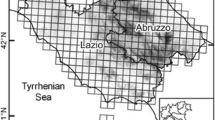Abstract
The differentiation of river flood plain vegetation is predominantly determined by the inundation frequency and the type and age of the substrate. A comparison of data published in 1958 with recent relevés from all parts of Switzerland indicate that the hitherto known gradient- and group structure is disintegrating into multiple floristically isolated stands as a result of waterflow management constructions. In view of further vegetation mapping, a two-phase classification is proposed where the core of the gradients and groups is isolated and analysed first. The outliers are then re-attached to serve as possible indicators of the existence of variation not sufficiently described by the data. To structure the tedious analytical calculations involved, a hierarchical procedure has been developed.
Similar content being viewed by others
Abbreviations
- AOC =:
-
Analysis of concentration
- CA =:
-
Correspondence analysis
- PCA =:
-
Principal components analysis
References
BrambillaC. & SalzanoG. 1981. A non-metric multidimensional scaling method for non-linear dimension reduction, Theory and computer program. Rome, Italy. Instituto per le Applicazioni del Calcolo. Ser. III, No. 121.
DagetM. B. & GodronM. 1982. Analyse fréquentielle de l'écologie des espèces dans les communautés. Masson, Paris.
EllenbergH. 1982. Vegetation Mitteleuropas mit den Alpen. 3. Aufl., Ulmer, Stuttgart.
EllenbergH. & KlözliF. 1972. Waldgesellschaften und Waldstandorte der Schweiz. Mitt. Schweiz. Anst. Forstl. Versuchsw. 48: 589–930.
FeoliE. & OrlóciL. 1979. Analysis of concentration and detection of underlying factors in structured tables. Vegetatio 40: 49–54.
GauchJrH. G., 1982. Multivariate analysis in community ecology. Cambridge Univ. Press, Cambridge.
GoodallD. W. 1969. A procedure for the recognition of uncommon species combinations in sets of vegetation samples. Vegetatio 18: 19–35.
GoodallD. W. & FeoliE. 1988. The application of probabilistic methods in the analysis of phytosociological data. Coenoses 3: 1–10.
HainardP., BressoudB., GiugniG. & MoretJ.-L. 1987. Wasserentnahme aus Fliessgewässern. Auswirkungen verminderter Abflussmengen auf die Pflanzenwelt. Bundesamt für Umweltschutz, Bern. Schriftenreihe Umweltschutz 72.
HellerH. 1969. Lebensbedingungen und Abfolge der Flussauenvegetation in der Schweiz. Mitt. Schweiz. Anst. Forstl. Versuchsw. 45: 1–124.
HillM. O. 1974. Correspondence analysis: A neglected multivariate method. Appl. Stat. 23: 340–354.
HillM. O. 1979. TWINSPAN—a FORTRAN program for arranging multivariate data in an ordered two way table by classification of individuals and attributes. Ecology & Systematics, Cornell University, Ithaca, New York.
JanceyR. C. 1979. Species ordering on a variance criterion. Vegetatio 39: 59–63.
KenkelN. & OrlóciL. 1986. Applying metric and nonmetric multidimensional scaling to ecological studies: some new results. Ecology 67: 919–928.
Kuhn, N. 1987. Distribution, general ecology and characteristics of European riparian forests. In: Imboden, E. (ed.), Riverine forests in Europe. Status and conservation. ICBP Symposium 1985: 7–15. Cambridge.
MinchinP. R. 1987. An evaluation of the relative robustness of techniques for ecological ordination. Vegetatio 69: 89–107.
MoorM. 1958. Pflanzengesellschaften schweizerischer Flussauen. Mitt. Schweiz. Anst. Forstl. Versuchsw. 34: 221–360.
Mueller-DomboisD. & EllenbergE. 1974. Aims and methods of vegetation ecology. Wiley & Sons, New York.
OrlóciL. 1978. Multivariate analysis in vegetation research. 2nd ed. Junk, The Hague.
OrlóciL. & StanekW. 1979. Vegetation survey of the Alaska Highway, Yukon Territory: Types and gradients. Vegetatio 41: 1–56.
PielouE. C. 1984. The interpretation of ecological data, A primer on classification and ordination. Wiley & Sons, New York.
PodaniJ. 1984. Spatial processes in the analysis of vegetation: Theory and review. Acta Bot. Hung. 30: 75–118.
PopmaJ., MucinaL., vanTongerenO. & van derMaarelE. 1983. On the determination of optimal levels in phytosociological classification. Vegetatio 52: 65–75.
Wildi, O. 1989. A new numerical solution to the traditional phytosociological tabular classification. Vegetatio. In press.
Wildi, O. & Orlóci, L. 1983. Management and multivariate analysis of vegetation data. 2nd revised ed. Eidg. Anst. Forstl. Versuchsw., Ber. 215, 139 pp.
Wildi, O. & Orlóci, L. 1988. MULVA-4, a package for multivariate analysis of vegetation data. Eidg. Anst. Forstl. Versuchsw. Polycopy, 122 pp.
Author information
Authors and Affiliations
Rights and permissions
About this article
Cite this article
Wildi, O. Analysis of the disintegrating group and gradient structure in Swiss riparian forests. Vegetatio 83, 179–186 (1989). https://doi.org/10.1007/BF00031690
Accepted:
Issue Date:
DOI: https://doi.org/10.1007/BF00031690




